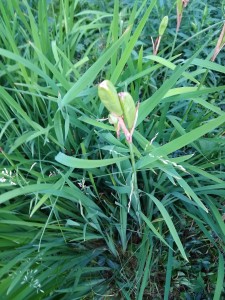 Summer is here, but many of us are still locked in the clutches of spring. Why? Because the remnants of the swell garden party that was the spring growing season are still with us. Think of all the flashy “guests” at that party—roses, clematis, peonies and iris of all sorts. They thrilled us all, garnered compliments and graciously allowed us to claim credit for the festival of color and garden exuberance. Now they have left the scene, except for a few Japanese iris hanging around in some places, and gardeners are left with the morning-after hangover.
Summer is here, but many of us are still locked in the clutches of spring. Why? Because the remnants of the swell garden party that was the spring growing season are still with us. Think of all the flashy “guests” at that party—roses, clematis, peonies and iris of all sorts. They thrilled us all, garnered compliments and graciously allowed us to claim credit for the festival of color and garden exuberance. Now they have left the scene, except for a few Japanese iris hanging around in some places, and gardeners are left with the morning-after hangover.
A few hot days withered the remaining daffodil foliage in the least attractive way. Roses have dropped their petals and need to be cut back to stimulate regrowth. German iris still have their dramatic sword-shaped leaves, but the flowers have evaporated, leaving only gray-brown remnants as a reminder of their bodacious blooms. The large-flowered clematis, which look almost tropical in bloom, are now half gone. The browning flowers have not yet given way to the elegant seedheads and the effect is less than inspiring. The flowering shrubs, like deutzia, weigela, lilac and spirea, have put on a magnificent spring show, but are now sporting new growth in every direction, which is the horticultural equivalent of waking up with severe bedhead after a wild night of revelry.
And, to top it all off, the weeds that have been lurking under that dying daffodil foliage, or growing tall in the middle of abundant catmint wands, have come into their own. The avalanche of bamboo-like stilt grass and the ominous creep of crabgrass are beginning to make the spring onion epidemic look tame by comparison.
All this happens overnight. Or perhaps it just seems like that, as gardeners are called away to promotions, graduations, weddings, picnics and all the other spring celebrations. Somehow, having an actual hangover makes the spring garden hangover that much worse.
What to do? Try your best to multi-task in the available time. I find that harvesting the withered daffodil, hyacinth and tulip foliage is very compatible with ridding specific areas of the weeds underneath those desiccated leaves. Shearing back catmint will give you a chance to get at the nasties, like porcelain berry and wild grape, which have twined their way through the more desirable plants in egregious fashion. Make sure you get the roots out, because if you don’t, they will begin a renewed attempt at garden domination before you even have time to put your tools away.
If you have a mid-size to large garden and are working in a specific area, do all you can to make that one area cleaned-up and ready for summer. If the dead daffodil leaves are close to the bloomed-out deutizia, for example, clip the deutzia back by one third right after you collect the daffodil remnants and pull up the weeds around them. If you have had the forethought to lay in a supply of mulch, apply it to the newly liberated area. The finished look will make you feel like a gardening genius.
Use a large-scale approach if you have to cut back swathes of iris foliage. I sharpen my garden shears and take on the large clumps of Siberian iris in one fell swoop, raking out the clipped leaves at the end. This is a good time to divide iris, but you can also leave it for later if other chores demand your attention.
Reblooming roses can also be cut back by one third, and you don’t have to be overly particular about where you make the specific cuts. If the weather is dry, make sure the newly-barbered roses get some extra water. Naturally, those roses should be mulched already, but if you haven’t had the time yet, this is the moment.
With summer upon us, all the daisy family members, including Shastas, coneflowers and coreopsis, are poised to make their grand entrance. Getting rid of the spring remnants provides them with the requisite elbow room. It also opens up spaces for annuals, which are abundant right now in the garden centers. Replacing spent spring foliage with zinnias, petunias, geraniums or coleus—for shady spaces—provides color and a full look without disturbing the sleeping bulbs beneath.
And when you are prioritizing all the tasks that will free your garden from spring’s clutches, remember to start with the jobs or garden areas that are the most meaningful for you. If you long to sit on your shady patio on a hot day savoring a good book, tidy that area first and fill the empty spaces with color.
And remember, garden progress is good; garden-related guilt is like stilt grass for the gardener’s soul.
